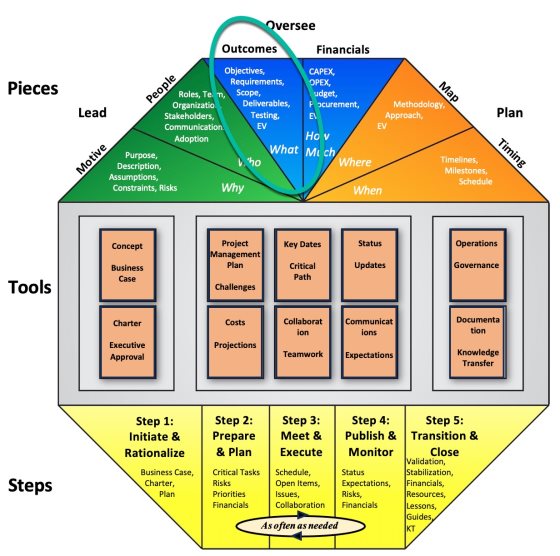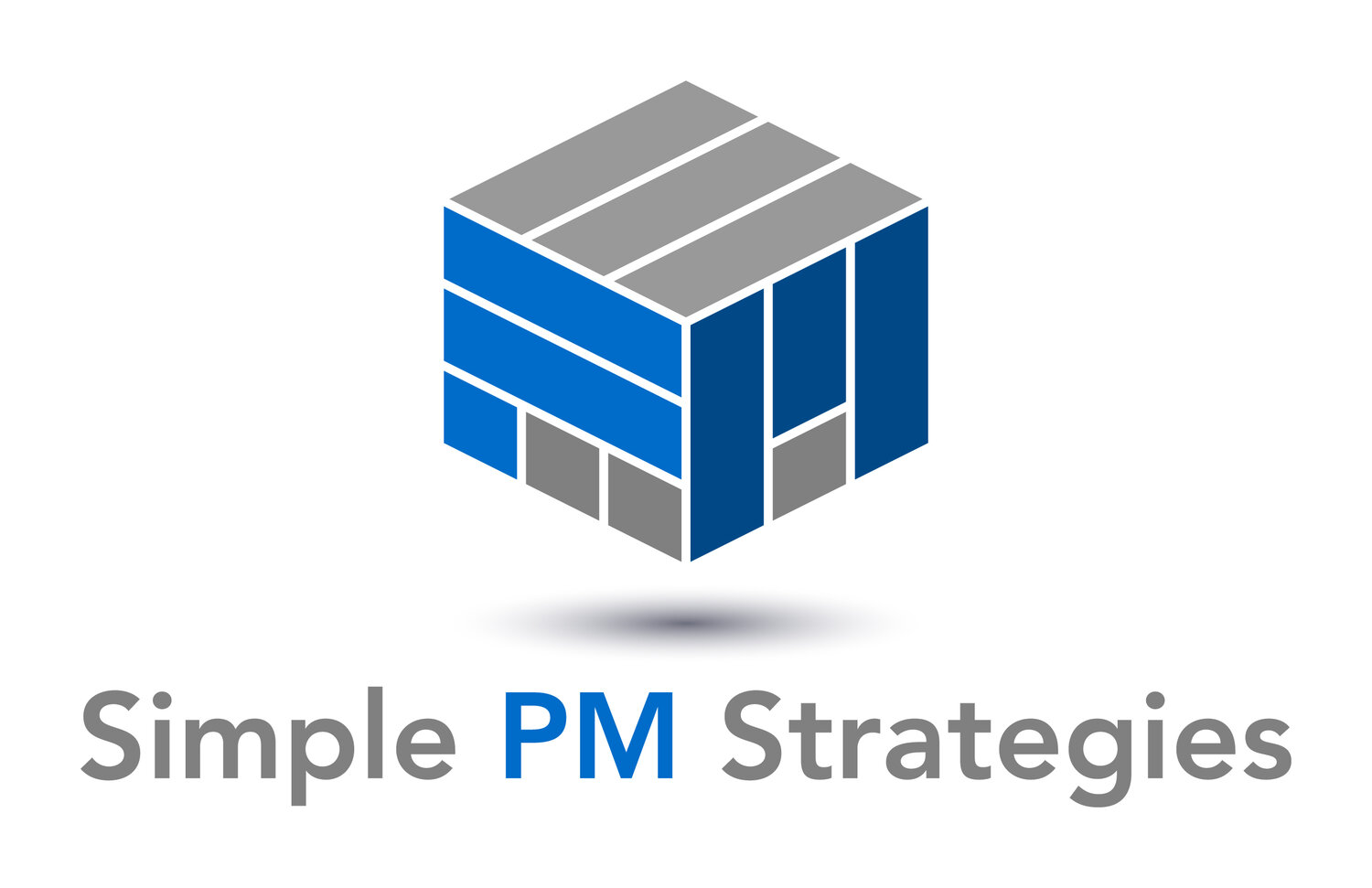Use 2 Criteria to Create Objectives That Work for You
The purpose of this article is to explain the importance of measurable objectives to your project’s success.
Objectives are project pieces under the OVERSEE domain and the Outcomes segment in the MPM model.

Objectives are project pieces under the OVERSEE domain and the Outcomes segment in the MPM model
Objectives Tell You When You are Done
How do you know when your project is done? When can you consider it successfully completed? What does “done” look like?
You define your project purpose but it’s important to figure out what the concrete outcomes of that purpose are: this is where your objectives come in.
Your objectives provide a measure of whether or not your project’s purpose has been achieved.
Your project finishes when your objectives have been achieved so being able to identify when it is done can be tricky if your objectives aren’t clearly defined at the start.
Objectives are measurable, but high-level enough such that they don’t change during the project. They create a tangible definition of your purpose, by drawing a finish line for your team.

Objectives tell you when you’ve crossed the finish line
If you look at your project as a race, the purpose tells you why you’re running, and the objectives tell you when you’ve crossed the finish line.
If you can’t tell when your purpose is achieved, your project can run on until you are out of money or time.
Project MPM Model
At Simple PM Strategies, we have used a visual model called the MPM model to define the project elements and describe how to manage as in the diagram below.
Objectives is under OVERSEE because it is something that you have to measure, manage and oversee the creation of throughout the project. However they should be defined initially in the beginning when developing the charter.
Measuring Your Outcomes
How do you make things measurable? Make sure that your objective statements contain quantifiable units of measure.
Units of measure examples:
- Dates
- Financial amounts
- Distance, such as meters or feet
- A yes or no related to a tangible deliverable like a report or decision
- A defined increase in capability, efficiency or productivity, whether as a number or a percentage
- A metric about the customer experience, but one with yes/no criteria or a clear way to measure success
One way to think about objectives is to imagine you’re an outsider to your project and if at the time the project finished and you were handed the list Objectives each with its own value to measure if it was done or not. Would you be able to affirmatively state whether or not each had been achieved?
For example, if your Objective is “achieve sufficient production capacity”, how do you determine what “sufficient” means? That could be a set of moving goalposts, that no one could agree on, especially your Stakeholders.
In contrast, if you said that you wanted to increase capacity by 10%, or decrease time spent on a particular task by 20 minutes per person, you can measure those things: the difference between the values at your project start vs the end will tell you if you’ve achieved your goals.
Most likely you have heard of the SMART acronym often floated about when defining objectives, made up of the first letter of each of the following words: Specific, Measurable, Achievable, Realistic, Time-bound.
You can achieve all of these by focusing on something that can objectively (notice the root word “objective”) defined and measured.
Define Clear Objectives at the Outset
Going back to our vehicle purchase project example covered in the INITIATE main article, objectives need to be defined at the outset.
For the vehicle project, which we have covered in a number of blog articles, the cost range of the vehicle or the deadline that you need your new vehicle by are measurable and those objectives drive the focus of the project.
A first Objective could be a vehicle purchase – and you’re successful if you end up buying a car, and unsuccessful if you don’t buy one, whatever the reason. So, that’s one objective. Either you do or you don’t – there isn’t a halfway state.
A second objective might be financial: to find a car above a certain amount and below a maximum value.
You can have a third objective relating to needing to purchase within a certain time frame, say before October 1, to use it for winter driving.

Objectives like timelines and costs need to be measurable.
Your Objectives Should be Relevant and High-Level Enough to Satisfy Your Purpose
You could add in other objectives around the age of the vehicle, maybe even a vehicle colour, but you have to ask yourself if those are relevant to achieving your purpose.
Are they requirements that have some flexibility in them, in other words, are they really necessary to achieving the project purpose?
Buying a car before the winter is important in a way that finding a car that’s bright red rather than navy is not: one directly motivates you in your car purchase in a way that the other doesn’t.
Make sure that your objectives are critical to your purpose – that’s how you can tell your objective is something you want to measure.
Ask yourself if the achievement of the objective is paramount to the success of your purpose. Can you look back when your vehicle purchase project completes, confirm the objectives were achieved, and say to yourself, “yes, I am satisfied with what I set out to achieve”?
The objectives guide you as your project moves through twists and turns of attempting to satisfy your requirements and achieve your deliverables. If colour is a nice to have in your project, that means you’re willing to change your mind if there’s a good reason for it.
Going back to the colour of your vehicle, if you want a bright red car, your friend might point out that vehicles of that shade are more frequently targeted for ticketing, because they stand out. Maybe for you that’s a good reason to go for a more neutral colour, so you might change your mind.
Changing your mind on this won’t mean that your project is unsuccessful – you can still buy a vehicle by the winter and get one within your budget; the colour won’t affect these.
So, specify your objectives carefully: make sure they represent the successful achievement of your purpose and truly measure what is important.
Define your Objectives during INITIATE
In the personal example of a vehicle purchase project, going through INITIATE and RATIONALIZE helps with defining your objectives.
Objectives help crystallize your ideas, so that you can be consistent and confident in your discussions with your stakeholders instead of being all over the map, changing your opinions about what project success means to you.
Business projects are no different. Creating measurable objectives are necessary to organize your thoughts and formalize your priorities.
Summary
Project resources, time and money are scarce, so it is important to ensure that you have measurable objectives to guide decision making during the project, even as requirements and deliverables may need re-shaping and changing.
Having objectives that are defined and measurable ensures that as the project proceeds you can make decisions as things change and yet when the project is done feel assured that you can confidently say that you achieved your project purpose.
Action Steps / Apply This Knowledge
- Review your project’s objectives and ask yourself if at the conclusion of the project, regardless of who is measuring them that the conclusions about whether or not they were achieved would be the same for anyone.
- Add quantitative values to any objectives which do not satisfy the criteria in 1 above. Verify any changes with your key Stakeholders.
- Prompt engineering guidance for AI GPTs such as chatGPT: “I’m a business leader launching a project that will be delivering X and Y. What are some suggestions of what to use for measurable objectives and what would those measures be?”
Learn More to Do More
Business evolves through change initiatives otherwise known as projects. The key to managing these change initiatives so you have more time, and less stress is to use simple strategies and tools.
Check out the Learning Hub’s other Articles with Actionable Steps, organized with a busy leader in mind, by topic or main idea, and with some AI GPT (e.g. ChatGPT) prompt engineering suggestions under the Action steps: https://simplepmstrategies.com/learning-hub-index
OVERSEE-Measurable Objectives
© Simple PM Strategies 2024
